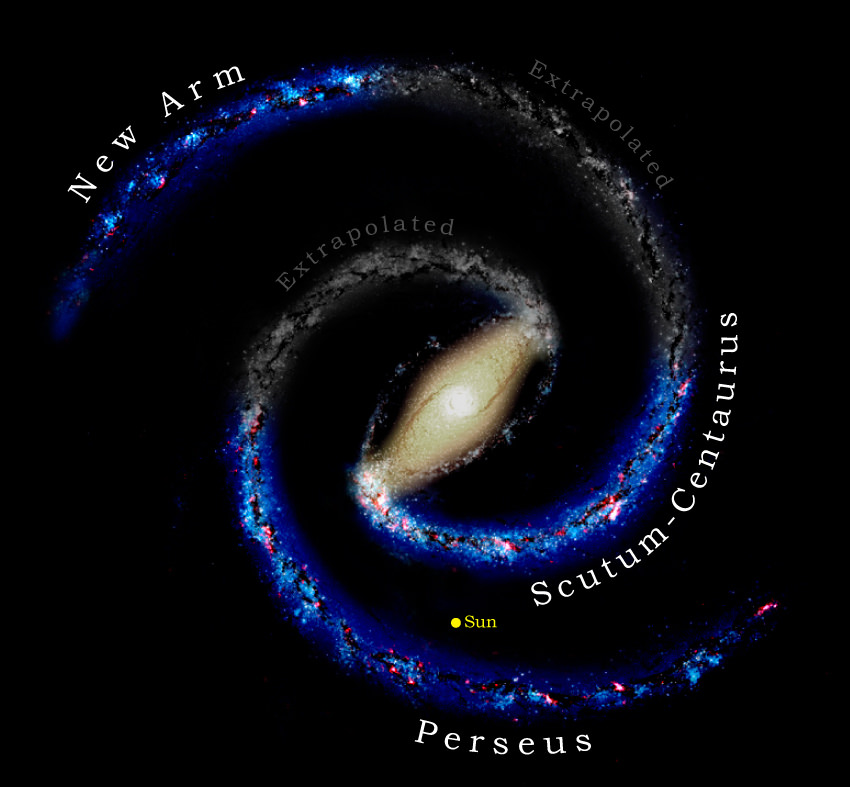[/caption]
Our Milky Way Galaxy’s elemental form is hypothesized to be a barred structure – made up of two major spiral arms originating at both poles of the central bar. But from our vantage point, we can only see portions of those arms. Because of huge amounts of dust literally blocking our view, we can’t be as confident of our structure as other galaxies we can study as a whole. However, by “sniffing our galaxy’s tailpipe”, we’re able to judge our structure just a little bit better.
We’re all aware of theoretical models of the Milky Way… a sprawling, pinwheel-like structure with sweeping, grandiose arms loaded with stars, gases and dust. We’re also aware our Solar System is lodged in a spur of those arms, slowly orbiting and located about 25,000 light-years from the center. But hard and fast details of our Galaxy haven’t been possible until now. Thanks to the use of radio waves, we’re able to cut through the murk and see wavelengths that give us clues. These architectural hints are coming to us in the forms of molecules like carbon monoxide – a great tracer of our galactic format.
Using a small 1.2-meter radio telescope on the roof of their science building in Cambridge, CfA astronomers Tom Dame and Pat Thaddeus used carbon monoxide emissions to ferret out proof there is more spiral structure located in the most distant parts of our galactic home. What they uncovered was a previously reported new spiral arm at the far end of the Scutum-Centaurus Arm – but how they did it was by verifying vast, dense concentrations of this molecular gas.
Where does it come from? Try the “exhaust” of carbon stars. These late-type stars have an atmosphere which is higher in carbon than oxygen. When the two combine in the upper layers of the star they create carbon monoxide. It also happens in “normal” stars like our Sun, too. It’s richer in oxygen than carbon, but still cool enough to form carbon monoxide. “After preliminary Galactic surveys in the mid-1970’s revealed the vast extent of CO emission on the sky,” says Dame, “It became clear that even with the relatively large beams of the 1.2 meter telescopes a sensitive, well-sampled survey of the entire Galaxy would require many years.”
And its time has come…
Original Story Source: Smithsonian Astrophysical Observatory.


I think I’ll claim a star in the new arm. I need a place to put a summer house.
The Milky Way – to be armed with evidence.
Galaxies have the right to bear arms too!
Don’t know why, but I always thought there were more arms to our Galaxy… something like in this image: http://casswww.ucsd.edu/archive/public/tutorial/MW.html
The picture you linked to still has just the two arms but with more exageration and and branching.
Yes, but the Sun is in a different place somehow. I guess everyone has his own interpretation
The sun is in a spur coming off the Sagittarius arm. The Sagittarius arm is smaller and we are on a small branch off of that. So it is like living in the suburbs of a smaller city in a land with two big cities.
LC
N.B. At the bottom of that professor’s website, which you’ve linked to, it states: “Last updated: 28 April 1999”!
The caption says “Other known spiral arm segments–including the Sun’s own spur–are omitted for clarity.”
Well, well. Normally such news occur around the AAS meetings, don’t they? 😉
Every now and then the Milky Way changes its appearance (neither literally nor physically, of course); I wonder, if we ever get a clear picture. It’s just so hard to deduce a form while being imprisoned on the inside….
Yo Tammy, at the last sentence: its, not “it’s”.
ah hah! i got you on that one… “it is richer in oxygen”… therefore the it’s is it! 😀
Sorry Tammy, the grammar police are right: “And it’s time has come…”
duh. can you tell i’m a natural blonde?
Er… Tammy, I was not referring to that phrase; I was referring to the last sentence, as pointed out by Michael Dwyer.
What do you mean by “What they uncovered was a previously reported new spiral arm ..”?
Should that be “previously unreported”?
hi, george! i did a similar story on dame and thaddeus’ work about a month ago and i didn’t want readers to think i was repeating myself… hi, george! i did a similar story on dame and thaddeus’ work about a month ago and i didn’t want readers to think i was repeating myself… hi, george! i did a similar story on dame and thaddeus’ work about a month ago and i didn’t want readers to think i was repeating myself… 😉
The Milky Way, our home galaxy, is turning to be larger than we thought
It looks like the new arm is a continuation of the Scutum Arm in the pic. This confused me. Is the Scutum Arm longer than we thought, or is the new arm an independant arm or spur?